2003 PONTIAC GRAND PRIX oil temperature
[x] Cancel search: oil temperaturePage 255 of 378
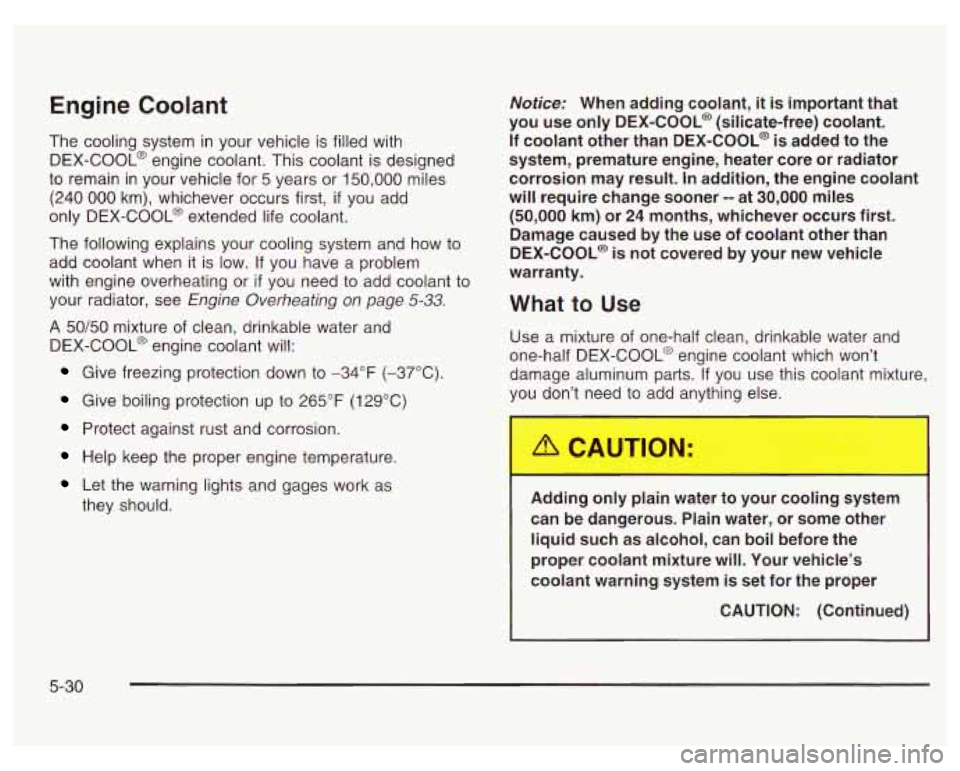
Engine Coolant
The cooling system in your vehicle is filled with
DEX-COOL@ engine coolant. This coolant is designed
to remain in your vehicle for
5 years or 150,000 miles
(240
000 km), whichever occurs first, if you add
only DEX-COOL@ extended life coolant.
The following explains your cooling system and how to
add coolant when it is low.
If you have a problem
with engine overheating or
if you need to add coolant to
your radiator, see Engine Overheating on page
5-33.
A 50/50 mixture of clean, drinkable water and
DEX-COOL@ engine coolant will:
Give freezing protection down to -34°F (-37°C).
Give boiling protection up to 265°F (129°C)
Protect against rust and corrosion.
Help keep the proper engine temperature.
Let the warning lights and gages work as
they should.
Notice: When adding coolant, it is important that
you use only
DEX-COOL@ (silicate-free) coolant.
If coolant other than DEX-COOL@ is added to the
system, premature engine, heater core or radiator
corrosion may result. In addition, the engine coolant
will require change sooner
-- at 30,000 miles
(50,000 km) or 24 months, whichever occurs first.
Damage caused by the use
of coolant other than
DEX-COOL@ is not covered by your new vehicle
warranty.
What to Use
Use a mixture of one-half clean, drinkable water and
one-half DEX-COOL@ engine coolant which won’t
damage aluminum parts. If you use this coolant mixture,
you don’t need to add anything else.
1 ---.-.g only p n water to your c 3 system
can be dangerous. Plain water, or some other
liquid such as alcohol, can boil before the
proper coolant mixture will. Your vehicle’s
coolant warning system is set
for the proper
CAUTION: (Continued)
I
5-30
Page 258 of 378
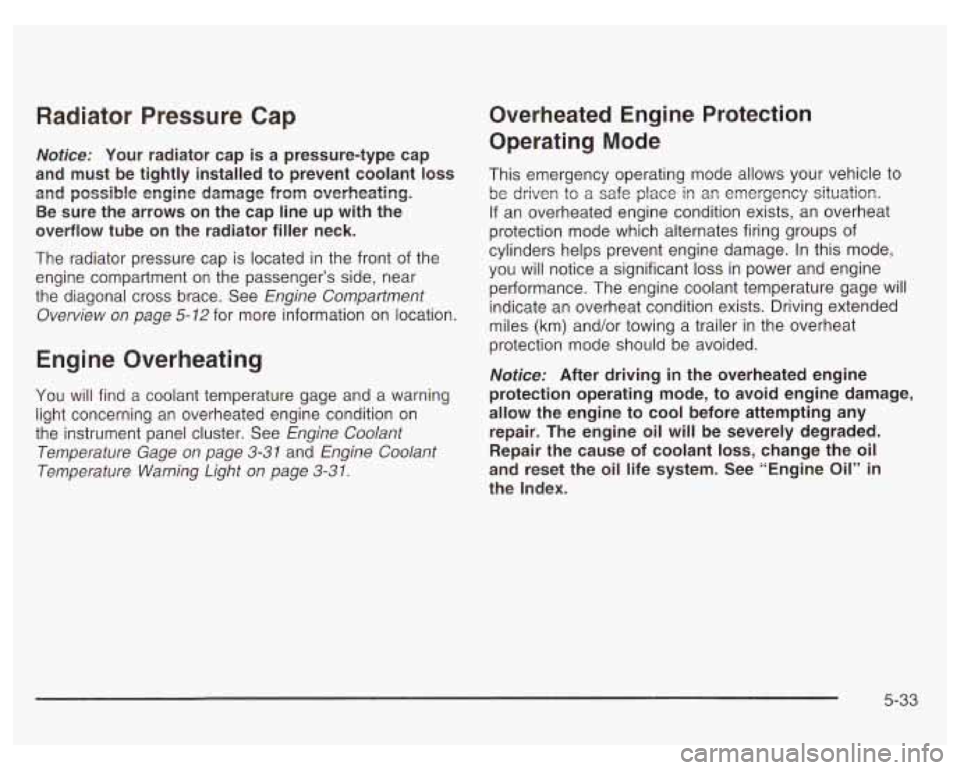
Radiator Pressure Cap
Notice: Your radiator cap is a pressure-type cap
and must be tightly installed to prevent coolant
loss
and possible engine damage from overheating.
Be sure the arrows on the cap line up with the
overflow tube
on the radiator filler neck.
The radiator pressure cap is located in the front of the
engine compartment on the passenger’s side, near
the diagonal cross brace. See Engine Compartment
Overview on page
5-12 for more information on location.
Engine Overheating
You will find a coolant temperature gage and a warning
light concerning an overheated engine condition on
the instrument panel cluster. See Engine Coolant
Temperature Gage
on page 3-31 and Engine Coolant
Temperature Warning Light
on page 3-31.
Overheated Engine Protection
Operating Mode
This emergency operating mode allows your vehicle to
be driven tu
a safe place in an emergency situation.
If an overheated engine condition exists, an overheat
protection mode which alternates firing groups of
cylinders helps prevent engine damage. In this mode,
you will notice a significant
loss in power and engine
performance. The engine coolant temperature gage will
indicate an overheat condition exists. Driving extended
miles (km) and/or towing a trailer in the overheat
protection mode should be avoided.
Nofice: After driving in the overheated engine
protection operating mode, to avoid engine damage,
allow the engine to cool before attempting any
repair. The engine oil will be severely degraded.
Repair the cause of coolant
loss, change the oil
and reset the oil life system. See “Engine Oil”
ir
the Index.
5-33
Page 334 of 378
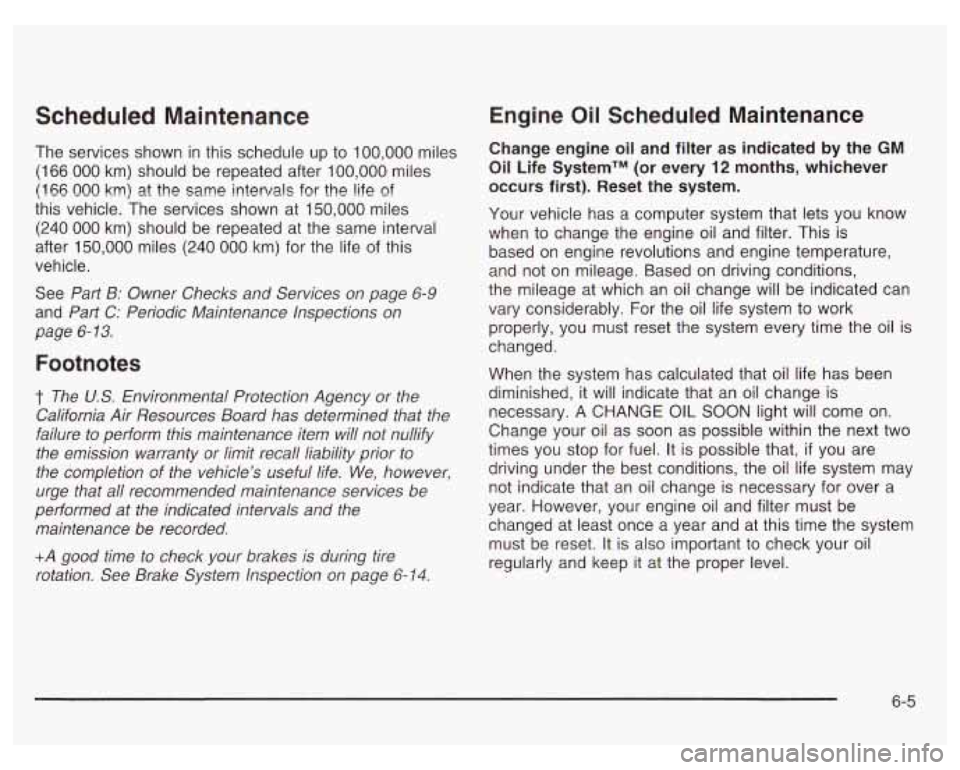
Scheduled Maintenance
The services shown in this schedule up to 100,000 miles
(1 66
000 km) should be repeated after 100,000 miles
(1 66 000 km) at the same intervals for the life of
this vehicle. The services shown at 150,000 miles
(240
000 km) should be repeated at the same interval
after 150,000 miles
(240 000 km) for the life of this
vehicle.
See Part B: Owner Checks and Services on page
6-9
and Part C: Periodic Maintenance Inspections on
page
6- 13.
Footnotes
t The U.S. Environmental Protection Agency or the
California Air Resources Board has determined that the
failure to perform this maintenance item will not nullify
the emission warranty or limit recall liability prior to
the completion of the vehicle’s useful life. We, however,
urge that all recommended maintenance services be
performed at the indicated intervals and the
maintenance be recorded.
+A good time to check your brakes is during tire
rotation. See Brake System Inspection on page
6-14,
Engine Oil Scheduled Maintenance
Change engine oil and filter as indicated by the GM
Oil Life SystemTM (or every 12 months, whichever
occurs first). Reset the system.
Your vehicle has a computer system that lets you know
when to change the engine oil and filter. This is
based on engine revolutions and engine temperature,
and not on mileage. Based on driving conditions,
the mileage at which an oil change will be indicated can
vary considerably. For the oil life system to work
properly, you must reset the system every time the oil is
changed.
When the system has calculated that oil life has been
diminished,
it will indicate that an oil change is
necessary.
A CHANGE OIL SOON light will come on.
Change your oil as soon as possible within the next two
times you stop for fuel. It is possible that,
if you are
driving under the best conditions, the oil life system may
not indicate that an oil change is necessary for over a
year. However, your engine oil and filter must be
changed at least once a year and at this time the system
must be reset.
It is also important to check your oil
regularly and keep it at the proper level.
6-5
Page 336 of 378
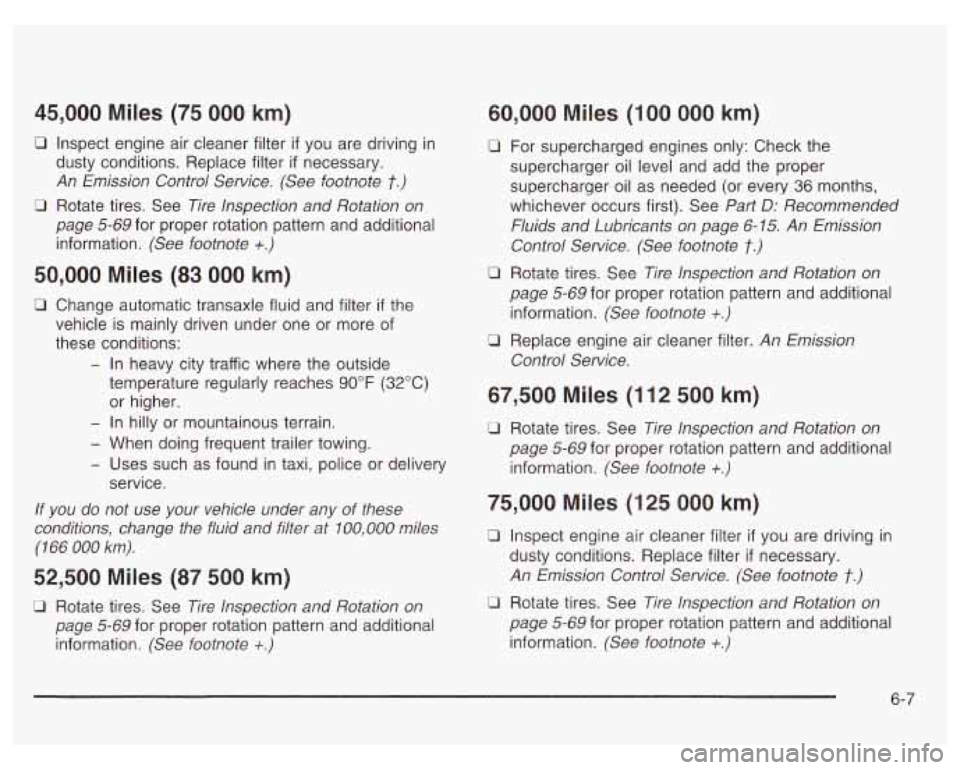
45,000 Miles (75 000 km)
0 Inspect engine air cleaner filter if you are driving in
dusty conditions. Replace filter
if necessary.
An Emission Control Service. (See footnote
t.)
0 Rotate tires. See Tire Inspection and Rotation on
page 5-69 for proper rotation pattern and additional
information. (See footnote
+.)
50,000 Miles (83 000 km)
0 Change automatic transaxle fluid and filter if the
vehicle is mainly driven under one or more of
these conditions:
- In heavy city traffic where the outside
temperature regularly reaches
90°F (32°C)
or higher.
- In hilly or mountainous terrain.
- When doing frequent trailer towing.
- Uses such as found in taxi, police or delivery
service.
If you do not use your vehicle under any of these
conditions, change the fluid and filter at
100,000 miles
(166
000 km).
52,500 Miles (87 500 km)
0 Rotate tires. See Tire Inspection and Rotation on
page 5-69 for proper rotation pattern and additional
information. (See footnote
+-)
60,000 Miles (100 000 km)
0 For supercharged engines only: Check the
supercharger
oil level and add the proper
supercharger oil as needed (or every
36 months,
whichever occurs first). See Part
D: Recommended
Fluids and Lubricants on page 6- 15. An Emission
Control Service. (See footnote
t.)
0 Rotate tires. See Tire Inspection and Rotation on
page 5-69 for proper rotation pattern and additional
information. (See footnote
+.)
Control Service.
0 Replace engine air cleaner filter. An Emission
67,500 Miles (112 500 km)
U Rotate tires. See Tire Inspection and Rotation on
page 5-69 for proper rotation pattern and additional
information. (See footnote
+.)
75,000 Miles (125 000 km)
0 Inspect engine air cleaner filter if you are driving in
dusty conditions. Replace filter
if necessary.
An Emission Control Service. (See footnote
t.)
0 Rotate tires. See Tire Inspection and Rotation on
page 5-69 for proper rotation pattern and additional
information. (See footnote
+.)
6-7
Page 337 of 378

82,500 Miles (137 500 km)
0 Rotate tires. See Tire Inspection and Rotation on
page
5-69 for proper rotation pattern and additional
information. (See footnote
+.)
90,000 Miles (150 000 km)
0 Replace engine air cleaner filter. An Emission
Control Service.
0 For supercharged engines only: Check the
supercharger oil level and add the proper
supercharger oil as needed (or every 36 months,
whichever occurs first). See Part D: Recommended
Fluids and Lubricants on page
6-15. An Emission
Control Service. (See footnote
f.)
Ll Rotate tires. See Tire Inspection and Rotation on
page 5-69 for proper rotation pattern and additional
information. (See footnote
+.)
97,500 Miles (162 500 km)
U Rotate tires. See Tire Inspection and Rotation on
page 5-69 for proper rotation pattern and additional
information. (See footnote
+.)
100,000 Miles (1 66 000 km)
0 Inspect spark plug wires. An Emission Control
0 Replace spark plugs. An Emission Control Service.
Service.
CI Change
automatic transaxle fluid and filter if the
vehicle is mainly driven under one or more
of
these conditions:
- In heavy city traffic where the outside
temperature regularly reaches
90°F (32°C)
or higher.
- In hilly or mountainous terrain.
- When doing frequent trailer towing.
- Uses such as found in taxi, police or delivery
service.
0 If you haven’t used your vehicle under severe service
conditions listed previously and, therefore, haven’t
changed your automatic transaxle fluid, change both
the fluid and filter.
150,000 Miles (240 000 km)
0 Drain, flush and refill cooling system (or every
60 months since last service, whichever occurs first).
See Engine Coolant on page
5-30 for what to use.
Inspect hoses. Clean radiator, condenser, pressure
cap and neck. Pressure test the cooling system
and pressure cap. An Emission Control Service.
0 Inspect engine accessory drive belt. An Emission
Control Service.
6-8
Page 364 of 378
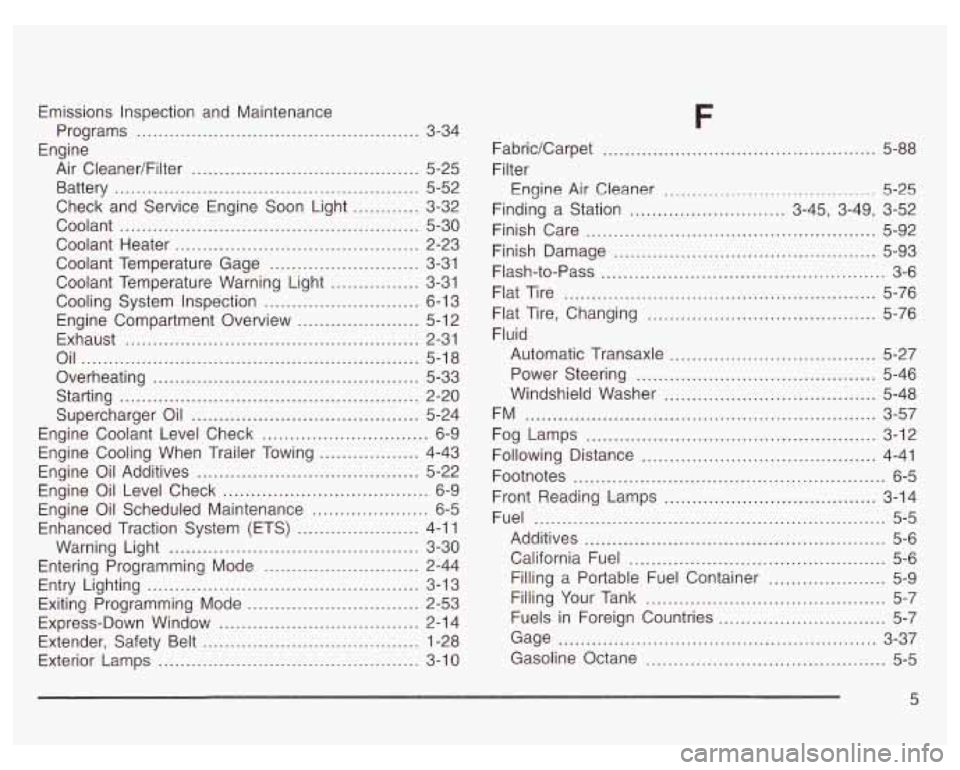
Emissions Inspection and Maintenance
Engine Programs
................................................... 3-34
Air Cleaner/Filter
......................................... 5-25
Battery
....................................................... 5-52
Check and Service Engine Soon Light ............ 3-32
Coolant
...................................................... 5-30
Coolant Heater
............................................ 2-23
Coolant Temperature Gage
........................... 3-31
Coolant Temperature Warning Light
................ 3-31
Cooling System Inspection
............................ 6-1 3
Engine Compartment Overview
...................... 5-1 2
Exhaust ..................................................... 2-31
Oil
............................................................. 5-18
Starting
...................................................... 2-20
Supercharger Oil
......................................... 5-24
Engine Coolant Level Check
.............................. 6-9
Engine Cooling When Trailer Towing
.................. 4-43
Engine Oil Additives
........................................ 5-22
Engine Oil Level Check
..................................... 6-9
Engine Oil Scheduled Maintenance
..................... 6-5
Warning Light
............................................. 3-30
Entering Programming Mode
......................... 2-44
Entry Lighting
........................ ...... 3-13
Exiting Programming Mode
.......... ...... 2-53
Extender, Safety Belt
.. ...................... 1-28
Exterior Lamps
............................................... 3-1 0
Overheating ................................................ 5-33
Enhanced Traction System (ETS)
...................... 4-1 1
Express-Down Window
................................. 2-1 4
F
, ........... FabridCarpet ........... ........... 5-88
Filter
Engine Air Cleaner ............................... :~~=:=~ 5-25
Finding a Station ............................ 3-45, 3-49, 3-52
Finish Care
.................................................... 5-92
Finish Damage
............................................... 5-93
Flash-to-Pass
................................................... 3-6
Flat Tire
........................................................ 5-76
Flat Tire, Changing
......................................... 5-76
Fluid Automatic Transaxle
..................................... 5-27
Power Steering
........................................... 5-46
Windshield Washer
...................................... 5-48
Fog Lamps
................................. , ........... 3-12
Following Distance
.......................................... 4-41
Footnotes
........................................................ 6-5
Front Reading Lamps
...................................... 3-14
Fuel
............................................................... 5-5
Additives ...................................................... 5-6
California Fuel
.............................................. 5-6
Filling a Portable Fuel Container
..................... 5-9
Filling Your Tank
........................................... 5-7
Fuels in Foreign Countries
.............................. 5-7
Gage
......................................................... 3-37
Gasoline Octane
........................................ 5-5
FM ............................................................... 3-57
5
Page 365 of 378

Fuel (cont.)
Gasoline Specifications
................
Low Warning Light ........ , ....
System Inspection .............
Functions ......................................
Fuses
Fuses and Circuit Breakers
....
Windshield Wiper ..............
.........
..........
..........
...........
........
...... 5-5
..... 3-37
..... 6-13
..... 3-39
..... 5-97
..... 5-97
G
Gage
Engine Coolant Temperature
......................... 3-31
Fuel
.......................................................... 3-37
Speedometer
.............................................. 3-25
Tachometer
................................................. 3-25
Garage Door Opener Compartment
................... 2-40
Gasoline Octane
........................................................ 5-5
Specifications ............................................... 5-5
Glass Surfaces
............................................... 5-90
Glove Box ..................................................... 2-40
GM Mobility Program for Persons with
Disabilities
................................... .. 7-5
Hazard Warning Flashers
................................... 3-3
Head Restraints
............................................... 1-6 Headlamp
Aiming
....................................................... 5-59
Headlamp Wiring
............................................ 5-97
Headlamps
.................................................... 5-60
Bulb Replacement
....................................... 5-60
Front Turn Signal and Sidemarker Lamps
....... 5-62
Halogen Bulbs
............................................ 5-60
Head-Up Display (HUD)
................................... 3-15
Heated Seats
................................................... 1-4
Highway Hypnosis
........................................... 4-25
Hill and Mountain Roads
.................................. 4-25
Hitches
.......................................................... 4-40
Hood Checking Things Under
................................ 5-10
Release
..................................................... 5-10
Horn
............................................................... 3-4
How to Add Coolant
to the Coolant
Recovery Tank
............................................ 5-38
How to Add Coolant
to the Radiator .................. 5-41
How to Add Fluid
............................................ 5-29
How to Check
........................................ 5-27, 5-69
How to Check and Add Oil
............................... 5-25
How to Check Power Steering Fluid .................. 5-47
How to Use This Manual ...................................... ii
How to Wear Safety Belts Properly ................... 1-12
Headlamp High/Low-Beam Changer
.................... 3-6
Hydroplaning
.................................................. 4-20
6
Page 367 of 378
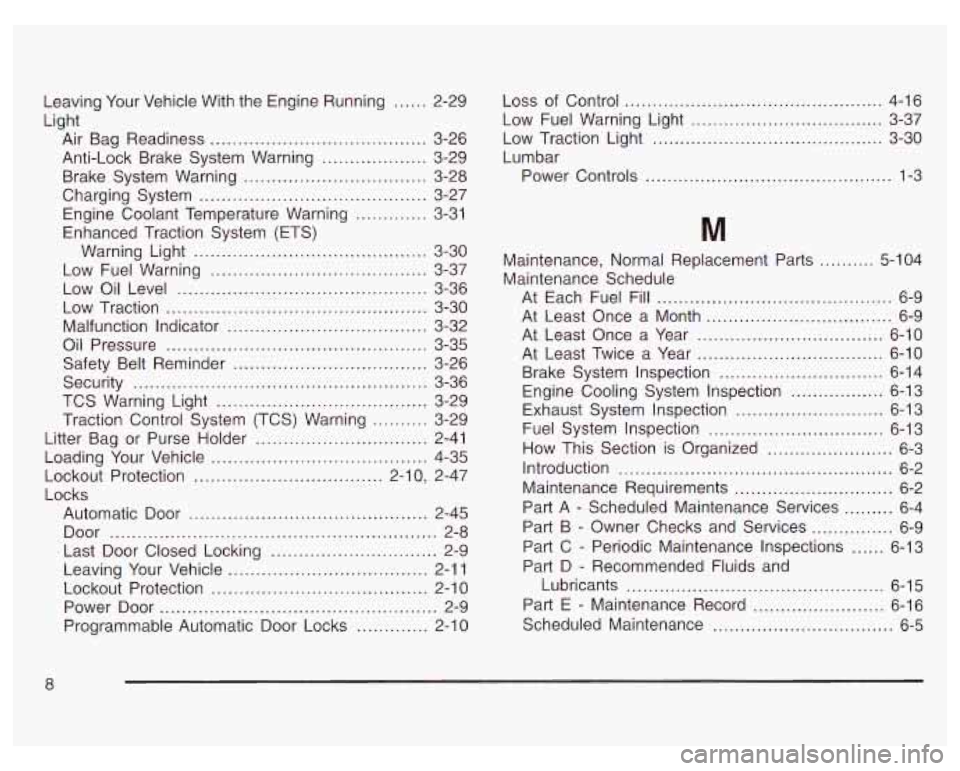
Leaving Your Vehicle With the Engine Running ...... 2-29
Air Bag Readiness
....................................... 3-26
Anti-Lock Brake System Warning
................... 3-29
Brake System Warning
................................. 3-28
Engine Coolant Temperature Warning
............. 3-31
Warning Light
.......................................... 3-30
Low Fuel Warning
....................................... 3-37
Light
Charging System
......................................... 3-27
Enhanced Traction System (ETS)
Low Oil Level
............................................. 3-36
Low Traction
............................................... 3-30
Malfunction Indicator
.................................... 3-32
Oil Pressure
............................................... 3-35
Safety Belt Reminder
................................... 3-26
Security
..................................................... 3-36
TCS Warning Light
...................................... 3-29
Traction Control System (TCS) Warning
.......... 3-29
Loading Your Vehicle
....................................... 4-35
Litter
Bag or Purse Holder
............................... 2-41
Lockout Protection
.................................. 2-10, 2-47
Locks
Automatic Door
........................................... 2-45
Door
........................................................... 2-8
Last Door Closed Locking
.............................. 2-9
Lockout Protection
....................................... 2-1 0
Power Door .................................................. 2-9
Programmable Automatic Door Locks
............. 2-1 0
Leaving Your Vehicle .................................... 2-1 1 Loss
of Control
.............................................. 4-16
Low Fuel Warning Light
................................... 3-37
Low Traction Light
...................................... 3-30
Lumbar Power Controls
........... ........... ... 1-3
M
Maintenance. Normal Replacement Parts .......... 5-1 04
Maintenance Schedule At Each Fuel Fill
........................................... 6-9
At Least Once a Month
.................................. 6-9
At Least Once a Year
.................................. 6-10
At Least Twice a Year
.................................. 6-10
Brake System Inspection
.............................. 6-14
Engine Cooling System Inspection
................. 6-13
Exhaust System Inspection
........................... 6-13
How This Section is Organized ....................... 6-3
Introduction
.................................................. 6-2
Maintenance Requirements
............................. 6-2
Part A
- Scheduled Maintenance Services ......... 6-4
Part B
- Owner Checks and Services ............... 6-9
Part C
- Periodic Maintenance Inspections ...... 6-13
Part D
- Recommended Fluids and
Lubricants
............................................... 6-15
Part E
- Maintenance Record ........................ 6-16
Scheduled Maintenance
................................. 6-5
Fuel
System Inspection
................................ 6-13
a